Must-have perennial bulbs
By Carol Cowan
What a pleasure for gardens of all skill levels to know that their careful selection and planting efforts will reap rewards for more than one season. This year's "Best of the Best" collection of 10 bulbs looks to perennial bulbs as the number one choice for 2002.
The first question that might come to mind is: "Hmmm, aren't all spring blooming bulbs perennials?" Well, with minor exceptions, and given our Canadian climate, yes they are. However, this collection is one of above average and more reliable perennializers. Frans Roozen, technical director of the International Flower Bulb Centre of Holland defines perennial bulbs as "those that will come back reliably for three to five years before diminishing," and naturalizing bulbs as "those which, on their own, increase in numbers year after year."
As a gardener, you can feel confident choosing part or all of this collection of reliable spring blooming perennial bulbs to add to your landscape. Plant once, enjoy for years to come, it couldn't be easier.
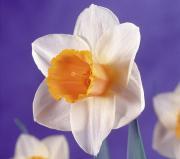 | 1. Narcissus 'Salome' Narcissus 'Salome' is definitely one of the finest commercially available large-cupped narcissi. Its creamy white petals contrast gracefully against the almost apricot cup, making a stunning display. It's an early to mid season bloomer, and grows to a height of about 35 cm. | |
| Narcissus 'Salome' | ||
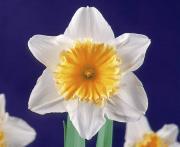 | 2. Narcissus 'Ice Follies' A quarter of a century ago, a Dutch couple celebrating their silver wedding anniversary received a present of 100 big bulbs of Narcissus 'Ice Follies' to plant in their orchard. The following spring, the 100 bulbs provided 175 flowers, as larger bulbs will often produce more than one flower stem. As of this spring, descendants of those 'Ice Follies' bulbs were still growing and blooming. The white petaled, yellow-cupped, early blooming flowers may be a bit smaller now, and, on occasion, a few bulbs may have failed to produce flowers, but the floral display remains almost as dramatic as it was in the spring after their silver wedding anniversary. This long flowering, 35 cm tall flower is not affected by either wind or rain. | |
| Narcissus 'Ice Follies' | ||
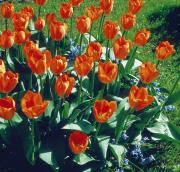 | 3. Tulipa 'Orange Emperor' This is a spectacularly coloured tulip with outside petals in a carrot-orange flushed with chartreuse and inside petals in orange, bleaching slightly to buttercup yellow at its base. A mid-season bloomer, it grows to a height of about 40 cm. | |
| Tulipa 'Orange Emperor' | ||
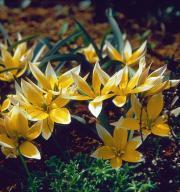 | 4. Tulipa tarda One of Tulipa tarda's most eye-catching characteristics is the appearance of its spreading, narrow, slightly wavy leaves that seem to shuffle their way across a garden's surface. These tufts form the basis for short (only 15 cm high), star-shaped flowers, which are yellow and tipped with white. Planted almost anywhere, in little spots where nothing else will grow, nestled among perennial ground covers or as bed edgings. This fragrant mid-season bloomer will thrive and come back again and again. | |
| Tulipa tarda | ||
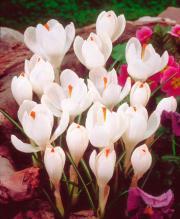 | 5. Crocus vernus 'Jeanne d'Arc' 'Jeanne d'Arc' is an impressive, large-flowering, pure white crocus, ideal on its own, in layered plantings with narcissi and tulip partners or as a companion planting with red-flowering Tulipa greigii. However they are used, they provide powerful visual impact. An early bloomer, 'Jeanne d'Arc' grows to a height of 10 cm. | |
| Crocus vernus 'Jeanne d'Arc' | ||
 | 6. Crocus tommasinianus 'Ruby Giant' Once the bulbs of Crocus tommasinianus 'Ruby Giant' have established, year after year their early flowering lilac-purple flowers emerge in seemingly infinite numbers. Because they are only 10 cm tall, they remain less affected by the wind and rain than many of their fellow crocuses. 'Ruby Giant' feels right at home in a lawn (scattered and planted where they fall), but also thrives in borders and among botanical roses and other woody plants. | |
| Crocus tommasinianus 'Ruby Giant' | ||
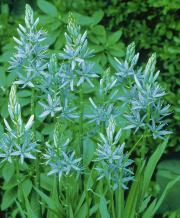 | 7. Camassia cusickii Native to the marshes and wet meadows of western North America, it wasn't until about 25 years ago that botanists started taking an interest in Camassia. Today, not only is this species being cultivated for commercial purposes, but also so are its cultivars (C. leichtlinii and C. quamash a.k.a. C. esculenta). Camassia cusickii grows to a height of about 70 cm. Its lively, star-like, grey-blue flowers appearing in large numbers on sturdy stems with decorative leaves make it a perfect partner for perennial and biennial plants. Flowering right at the transition between spring and summer, it also fills a gap when flowering plants are few and far between. | |
| Camassia cusickii | ||
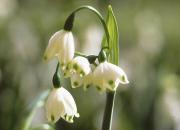 | 8. Leucojum aestivum Common names: meadow snowflake and summer snowflake. Leucojum aestivum features lush foliage, and its 35 cm stems, each bearing two to eight, 2 to 3 cm nodding white bells with petal tips spotted bright green, make this a stunning mid to late spring addition to the garden. Summer snowflakes prefer a moist location where sun is not too harsh. | |
| Leucojum aestivum | ||
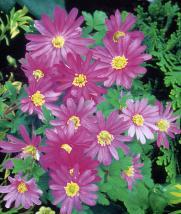 | 9. Anemone blanda 'Blue Shades' Common name: windflower. Rarely exceeding a height of 15 cm, Anemone blanda is great for introducing colour to spots where shrubs are still waiting to put on their show of foliage and/or flowers. Its long-flowering habit is also handy for prettying up individually planted perennials with somewhat plain foliage. At its peak, the plant's purple to lilac flowers are about the size of a loonie. A mid season bloomer. | |
| Anemone blanda 'Blue Shades' | ||
 | 10. Scilla siberica Common name: Siberian squill. The deep violet-blue of these star-to-bell-shaped nodding flowers surpass practically all other blue spring-flowering plants, and its leaves almost act as a ground cover. Plant Scilla siberica's smooth little purple bulbs en masse, as, each group of 100 bulbs shouldn't cost much more than a couple of garden gloves. Ideal for shrub, tree and evergreen underplantings. An early to mid season bloomer, Siberian squill reaches a height of about 15 cm. | |
| Scilla siberica |